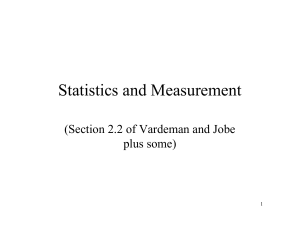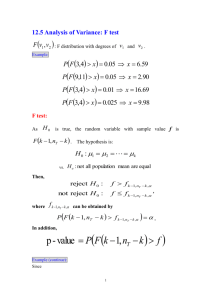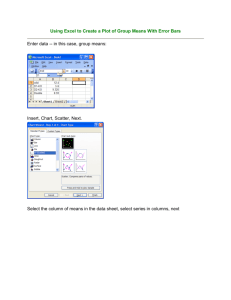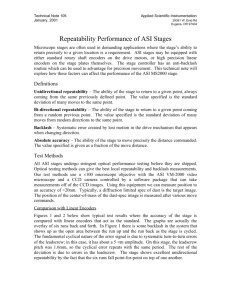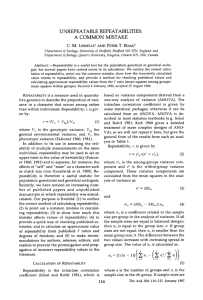Repeatability
advertisement
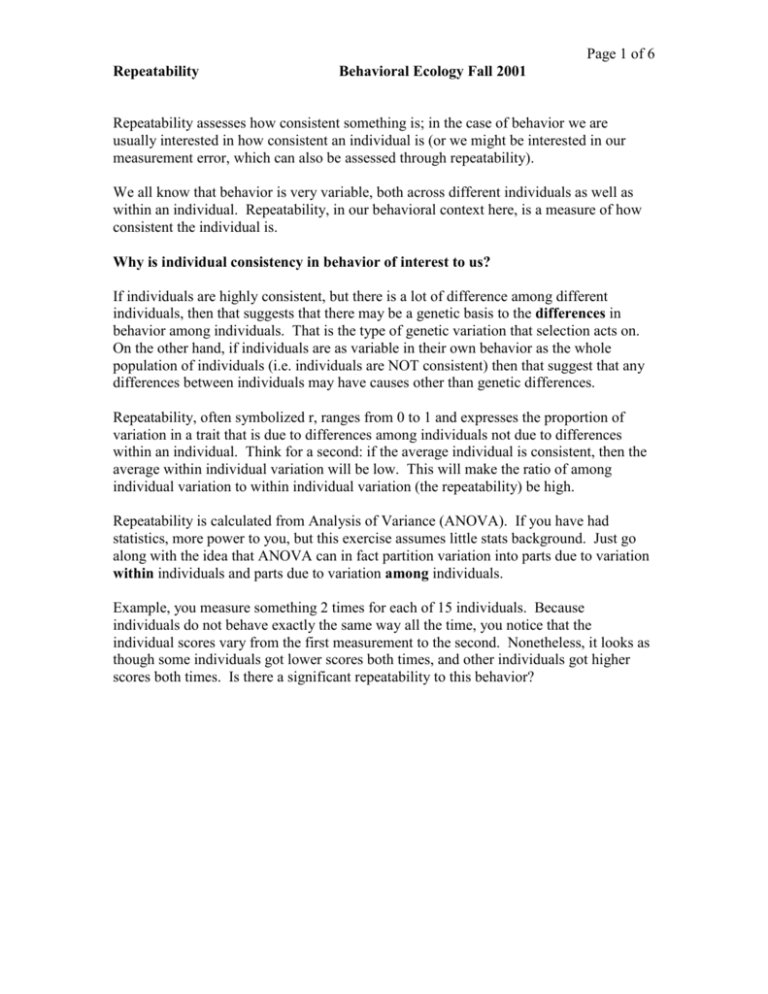
Page 1 of 6 Repeatability Behavioral Ecology Fall 2001 Repeatability assesses how consistent something is; in the case of behavior we are usually interested in how consistent an individual is (or we might be interested in our measurement error, which can also be assessed through repeatability). We all know that behavior is very variable, both across different individuals as well as within an individual. Repeatability, in our behavioral context here, is a measure of how consistent the individual is. Why is individual consistency in behavior of interest to us? If individuals are highly consistent, but there is a lot of difference among different individuals, then that suggests that there may be a genetic basis to the differences in behavior among individuals. That is the type of genetic variation that selection acts on. On the other hand, if individuals are as variable in their own behavior as the whole population of individuals (i.e. individuals are NOT consistent) then that suggest that any differences between individuals may have causes other than genetic differences. Repeatability, often symbolized r, ranges from 0 to 1 and expresses the proportion of variation in a trait that is due to differences among individuals not due to differences within an individual. Think for a second: if the average individual is consistent, then the average within individual variation will be low. This will make the ratio of among individual variation to within individual variation (the repeatability) be high. Repeatability is calculated from Analysis of Variance (ANOVA). If you have had statistics, more power to you, but this exercise assumes little stats background. Just go along with the idea that ANOVA can in fact partition variation into parts due to variation within individuals and parts due to variation among individuals. Example, you measure something 2 times for each of 15 individuals. Because individuals do not behave exactly the same way all the time, you notice that the individual scores vary from the first measurement to the second. Nonetheless, it looks as though some individuals got lower scores both times, and other individuals got higher scores both times. Is there a significant repeatability to this behavior? Page 2 of 6 Some pretend data: Individual Measurement Score 1 1 0.34325629 1 2 0.14305564 2 1 0.80843765 2 2 0.97922126 3 1 0.70119901 3 2 1.23151964 4 1 1.15389224 4 2 0.88256177 5 1 1.26174179 5 2 1.52169388 6 1 0.00791876 6 2 0.85306927 7 1 1.84605942 7 2 2.03122889 8 1 2.11409613 8 2 2.09923619 9 1 2.23405768 9 2 1.65710812 10 1 1.78042119 10 2 1.32637704 11 1 0.40223491 11 2 1.46224999 12 1 1.93175326 12 2 1.14711549 13 1 0.62974894 13 2 2.49582839 14 1 2.54894476 14 2 1.92692013 15 1 2.61080975 15 2 2.0333514 This is how you might keep your data in Excel if you are a well organized individual. But to do an ANOVA in MS Excel, you need to arrange your data like this: Sum of Score Individual Measurement 1 2 3 4 5 6 7 8 9 10 11 12 13 14 15 1 0.343 0.808 0.701 1.154 1.262 0.008 1.846 2.114 2.234 1.78 0.402 1.932 0.63 2.549 2.611 2 0.143 0.979 1.232 0.883 1.522 0.853 2.031 2.099 1.657 1.326 1.462 1.147 2.496 1.927 2.033 Experienced MS Excel users might want to use the Pivot table command to change their data around so that each individual is a column; otherwise do it the old slow way, cut and paste. Page 3 of 6 Once the data are arranged so that each individual is a column, highlight the data (not the column heading, etc, just the data) and then find Data Analysis in the Tools Menu. If it isn’t there, select Add Ins from the Tools Menu, and then check the Analysis Tools Pack button. Page 4 of 6 Once you have found Data Analysis you want Anova: Single Factor Hit ok, and this should appear: Page 5 of 6 You have to check the Output options Output range button, and then enter a cell destination where there is room on your worksheet, if you are unsure where there is room, just check the New worksheet ply button. Hit ok, and this appears: Page 6 of 6 Check that the computer cooperated. In the top part you should have the same number of groups as you have individuals (each individual is treated as a group in Excel lingo), each individual (group) should have a count of 2 observations (you observed each individual twice), as well as a sum, an average, and a variance. At the bottom is the ANOVA table. It is the information in here that you use to calculate repeatability. Notice first that Excel gives you a statistical test of whether or not a significant amount of the total variation is found by differences Between the different groups (individuals) RELATIVE to the amount of variation Within the groups. The statistic is the F test, with degrees of freedom (df) and the P-value. The P-value is the likelihood of finding as big a difference between groups as you did find IF THERE WERE NO TRUE DIFFERENCE. Here F with 14 and 15 df = 3.217, P = 0.016. That means that you have a 1.6% chance that there is NOT a true difference between groups. If this chance is low enough, then we might provisionally say that the groups ARE different. Usually in most of science if the chance is 5% or less we say it is statistically significant. Ok, so there is a 1.6% chance that the groups (individuals) are NOT different, so it looks as though they behaviors are in fact repeatable. So……. How do we calculate the repeatability r? r = S2A/(S2 + S2A) Where S2A is the between group variance and S2 is the within group variance. The S2 = the mean square within (MSW). Excel gives the MSW as the Within row MS column = 0.257 in this example. S2A = (MSA - MSW)/n0 And no is the weighted average number of observation per group (here we have 2 observations per individual, so no = 2, but you could have the case where you have different numbers of observations in each group. In which case: N0 = [1/(a-1)] * [SUM(ni) – (SUM(ni2)/SUM(ni)) So, in this example: S2 = MSW = 0.257 S2A = (MSA - MSW)/n0 = (0.828 – 0.257)/2 = 0.2855 r = S2A/(S2 + S2A) = 0.2855/(0.257 + 0.2855) = 0.526 That means that about 52% of the variation is due to differences among individuals, which can only happen if individuals are consistent. Recall that r ranges from 0 to 1, so an r of 0.5 is pretty consistent. Good Stuff Maynard.
